Managing Noise Levels in Classrooms
Posted by Kate Murphy on Jul 10th 2025
When classrooms start sounding like a hallway stampede of sneakers and a chorus of HVAC hums, it’s no wonder students can’t stay focused.
The American National Standards Institute recommends the sound level in an empty classroom should not exceed 35 decibels—a standard echoed by the World Health Organization. Yet research consistently shows that many classrooms have background noise levels topping 50-60 decibels, far above what is considered optimal for learning.
When left unmanaged, excess noise can undermine both teaching and learning. Fortunately, acoustic panels and other thoughtful interventions can help bring balance and focus back to classrooms. Here’s how to manage noise in a classroom effectively.

Why Noise Management Matters in Today’s Classrooms
Classrooms aren’t always quiet rows of desks—they’re buzzing hubs of teamwork and activity. But all that energy can come with a noisy side effect that makes focusing a real challenge for both students and teachers.
The Consequences of Unmanaged Classroom Noise
Excessive background noise in a classroom can originate from outside the building, such as aircraft and traffic noise, landscaping equipment, playground activity, or the weather. Noise can also come from inside, including air-conditioning, plumbing systems, adjacent classrooms, hallways, music rooms, or chatter from the students themselves.
Several studies have shown a negative correlation between classroom noise and test scores. Environmental noise disrupts children’s ability to concentrate, absorb information, and perform well academically.
Since students learn primarily by listening, reduced speech clarity severely hampers retention. Straining to hear raises stress levels, making focus even harder. Learners with sensory sensitivities, autism, ADHD, or hearing impairments are particularly vulnerable. Loud or sudden noises can trigger physical symptoms like increased heart rate, sweating, and muscle tension, amplifying anxiety, discomfort, and irritation.
Many educational leaders recognize classrooms have evolved from traditional lecture spaces into flexible, collaboration-driven environments with modular furniture, writable surfaces, makerspaces, and integrated technology. While these group-based approaches enrich instruction and build essential social skills, they also create acoustic challenges. Multiple groups working at once generate overlapping conversations and background noise. Without effective acoustic design—like sound-absorbing materials, thoughtful layouts, and noise-reducing partitions—these dynamic spaces can become distracting, making it harder for students to concentrate, process information, and participate fully.
And it’s not just the students who face noise fatigue. Teachers also face challenges, with loud classrooms contributing to voice strain and exhaustion that can affect their teaching quality and health.

Proactive Strategies for Managing Noise Levels in Classrooms
Keeping classroom noise in check doesn’t have to feel overwhelming. It starts with setting clear expectations and simple routines, so everyone knows when it’s time for lively discussion and when it’s time to listen. Visual cues, like noise-level monitors or “traffic light” systems, help students stay aware and adjust their volume in real time: green signals discussion time, yellow means students can whisper, and red indicates it’s time for silence.
A few smart design choices also go a long way. Soft furnishings like fuzzy-textured rugs, thick curtains, and cushioned seating help soak up sound. Rearranging tables to create designated group areas can prevent voices from bouncing around the entire room. And if you really want to turn down the volume, acoustic panels on walls or ceilings can make a big difference, improving clarity so everyone can hear and think more easily.
Choosing and Installing Acoustic Panels in the Classroom
Speaking of acoustic panels, if you’re considering these sound-absorbing sensations, here are a few key factors to guide your decision.
- Size and Coverage: Larger panels or greater coverage areas will generally deliver more noticeable improvements, especially in rooms with high ceilings or hard surfaces.
- Placement: Position panels on walls adjacent to primary noise sources or across from reflective surfaces (like windows or whiteboards) to maximize effectiveness.
- Material and Aesthetics: Panels come in a variety of colors, shapes, and fabrics. Select options that complement your classroom decor and are durable enough to withstand daily wear.
- Portable vs. Wall-Mounted Panels
- Portable panels offer flexibility, allowing you to reconfigure the room as needed. They can double as space dividers or visual displays.
- Wall-mounted panels provide a permanent, low-maintenance solution that doesn’t encroach on floor space.
If you’re interested in exploring acoustic panel options, visit the acoustic panels page to learn more about available styles and configurations, including freestanding, wall-mounted, desktop, and ceiling options.
Long-Term Benefits of Acoustic Improvements in Learning Spaces
Acoustic surfaces in schools offer several key benefits that enhance the learning environment. By improving speech intelligibility, they ensure students can hear and understand lessons clearly, even in larger classrooms. Reducing background noise helps minimize distractions, allowing students to focus better on their tasks and tests. A quieter atmosphere also lowers stress levels for both students and staff, fostering a more positive and calmer atmosphere. Additionally, acoustic treatments provide crucial support for inclusive learning, making classrooms more accessible for students with hearing impairments or sensory sensitivities.
Beyond performance, acoustic panels can enhance the look of a space. They add texture and visual interest while standing up to wear and tear. Plus, many panels double as durable, pin-friendly surfaces—perfect for showcasing student artwork, notes, and achievements—helping create a vibrant, personalized learning environment that lasts for years.

Bringing Harmony Back to the Classroom
Effective learning requires an environment where everyone can focus, collaborate, and thrive. Managing noise isn’t just about keeping the volume down—it’s about intentionally creating a space where clear communication and student success go hand in hand.
If you’re ready to bring harmony back to your classrooms, explore Versare’s full range of acoustic solutions and resources designed specifically for educational settings.


